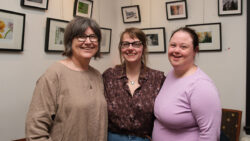A Canadian Museum of Nature mineralogist has been awarded one of the field’s most prestigious prizes for his striking photographs of geological specimens.
Michael Bainbridge, the Canadian Museum of Nature’s assistant curator of mineralogy and a highly accomplished photographer, was recently presented with the Carnegie Mineralogical Award at the annual Tuscon Gem and Mineral Show in Arizona, the largest of its kind in the world.
Bainbridge’s twin passions for minerals and photography “have afforded me access to some of the world’s great collections and sparked collaborations with some of the community’s most influential amateurs and professionals alike,” he said in a blog post on the museum website.
The award, presented by the Carnegie Museum of Natural History in Pittsburgh, is given every year to a person in the field who has made “outstanding contributions to the preservation, conservation, and education about minerals.”

Bainbridge’s work was also highlighted in an announcement published by the Pennsylvania museum.
“Over the course of his career, he has elevated the field of mineral photography, published in leading mineralogical publications, and contributed to groundbreaking works such as Minerals of the Grenville Province: New York, Ontario, and Québec,” said Travis Olds, Carnegie’s assistant curator of minerals and the presenter of the award to Bainbridge at the Tuscon show.
“Michael has blended art and science to preserve and showcase the beauty of minerals, inspiring collectors and researchers alike,” noted Olds. “He has immortalized some of the rarest and best-of-species minerals, and this award recognizes the many wonderful contributions he has made to mineral heritage through his lens.”
Bainbridge told the Carnegie museum he was “honoured and humbled” to accept the award.
“I love to teach, and I love to tell stories, but I think both are fueled by a desire to learn for myself,” Bainbridge stated in the award announcement. “I’ve always been technically minded but artistically inclined, so combining my passion for minerals with my love of photography has proven the perfect vehicle for me to pursue and share both the scientific and the aesthetic. It has afforded me access to some of the world’s great collections and sparked collaborations with some of the community’s most influential amateurs and professionals alike.”
In an interview with Capital Current, Bainbridge expressed shock at winning the prize.
“It’s quite a prestigious award and not something I ever even considered that I would be in the running for,” he said.
He noted that he has loved minerals since he began collecting them as a child.
“I started out as a kid, as a mineral collector,” he said. “My family signed up for the Ottawa Valley Mineralogical Association when I was a kid and that was associated with the Museum of Nature at the time. So that was my first introduction to minerals.”

He attended Niagara College for filmmaking, where he combined his love for minerals with photography.
“I went to school for filmmaking and worked as a filmmaker for a number of years before deciding I would combine my passions for photography and mineralogy into taking pictures of mineral specimens for museums and private collections,” said Bainbridge.
Among the countless minerals he has photographed are alamosite and tremolite, shown in the accompanying photos.
Each photo shows many details, such as the texture and colours, and allows viewers to grasp the different qualities of each mineral specimen.
A good mineral photograph “is in part about basic object, or studio, photography,” Bainbridge’s explained in the CMN’s article about his award. “Sometimes flourishes such as lighting the specimen from underneath will allow for a more artistic presentation.”
Bainbridge told Capital Current he can’t pick a favourite photo but that he loves every end result.
Although he has been focusing less on photography in recent years, Bainbridge said he still works with mineral collections at the museum: “My work in promoting and preserving mineralogy continues.”
Documenting mineral collections and educating the public are a big part of what Bainbridge does.
“I’ve been published in scientific journals and hobbyist publications all over the world,” he said. “I’ve written a couple of books and been featured in several others. Plus, I do a lot of public speaking about both mineralogy and photography.”
Bainbridge also recently helped launch the Ottawa Valley Mineral Club, which meets at the McLeod Street museum on the second Thursday of every month.

“Among my proudest accomplishments, the Pinch book stands in high relief,” Bainbridge told the Carnegie Museum after his award win. “Pushing the boundaries of photomicroscopy in documenting some of the smallest and rarest specimens . . . has been both challenging and rewarding.”
He added: “The significant finds I have made as a field collector are also close to my heart. But seeing new people come to the hobby through doors I have helped to open — whether through the Recreational Geology Project or co-founding the new Ottawa Valley Mineral Club — has perhaps been the most rewarding of all.”




